4 Apr 2016
Juan Hernandez-Garcia and Alasdair MacLeod review common problems contributing to neonatal mortality, and provide some action points.
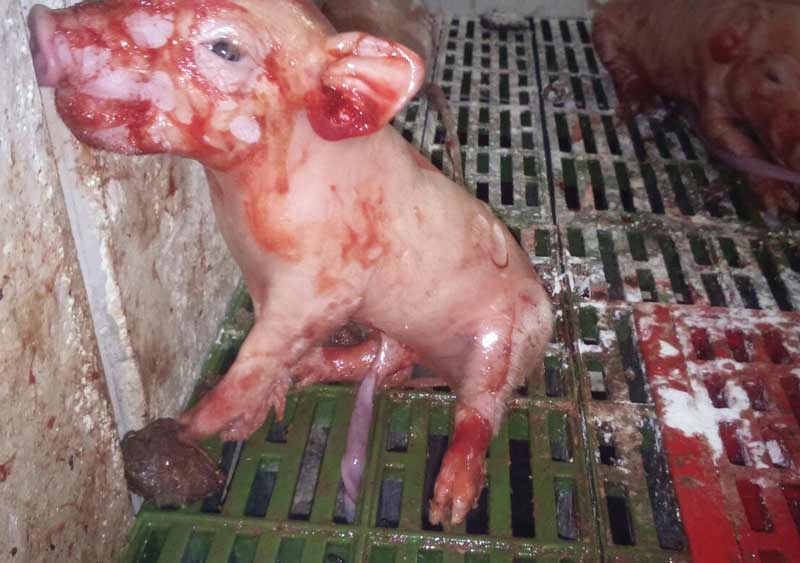
Figure 3. Newborn minutes after birth. Good hygiene and drying material increase piglets’ chances of survival.
Improvements in genetics, management and nutrition have allowed the number of piglets per litter to increase over time. Nowadays, well-managed highly prolific sows are able to farrow large litters (more than 14 born). Large litters and uterine crowding increase the incidence of light birthweight1 and long farrowing resulting in higher neonatal mortality2.
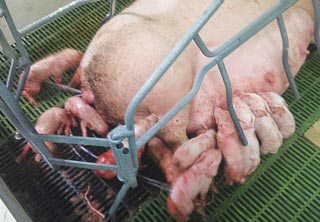
Literature reports that 15% to 30% of pre-weaning mortality occurs in the first 24 hours, and by the fifth day casualties can represent 7% to 9% of the total live born3-6; implementing enhanced management practices can considerably reduce casualties5-7. Neonatal mortality depends on a large number of factors that can be difficult to identify and control8,9. Good management protocols, balanced nutrition, proper environment and competent staff can make a big difference to the results10.
Sows and gilts play a main role in neonatal mortality; their voluntary feed intake, maternal traits – mainly based on genetics2,11-13 – and health status are important (Table 1)1,10,13-23.
Newborns piglets are really susceptible to poor environmental and hygiene conditions24. All-in all-out management and total cleaning and disinfection between batches helps to control infections in newborns10. Farrowing rooms may increase temperatures before the farrowing date to ensure perfect conditions for newborns. Heating systems (mats, bulbs) and nests should be ready to be used. As farrowing time cannot be completely predicted, sow faeces should be removed daily to enhance hygiene18.
Gestation length can physiologically vary from 113 to 117 days25,26. Farm recording systems, heat detection and insemination protocols can also affect the gestation length information the farmer has. Mistakes when estimating farrowing date (Table 2)10,18,25,26,29 can lead to farrowing in the gestation area (with high piglet mortality), inappropriate farrowing induction and lack of synchronisation of farrowing (which complicates adoptions).
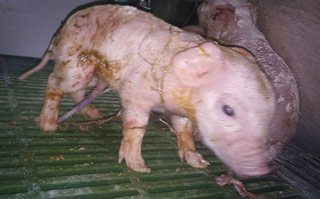
Ideally, farrowing should be promoted to happen in a short period of time, and – if convenient – induced to occur when staff are attending the sows. Pre-farrowing signs may be detected and labour progress should be recorded18. Piglets born late in order are at more risk of suffering complications27 and more than 70% of the stillbirths occur after the eighth piglet. Supervision of farrowing5 can increase piglets’ chances of survival as it can allow for obstetric explorations, and oxytocin, vetrabutin or calcium administration if necessary9,28.
Newborns should be dried and placed in a warm and dry area (in a nest, on a heating mat or under a heat lamp) to prevent hypothermia and reduce the crushing risk18,24,29. In cases of dystocia it is especially important to ensure they can breathe properly, as some piglets are born with hypoxia. Clean the airways and mouth and rub the rib cage while drying. The umbilical cord can be ligated to prevent bleeding10,29.
Pigs rely on passive immunity transference to cope with immunological challenges during the first weeks of life, so it is fundamental for survival8,30,31. Suckling behaviour can be promoted by providing a calm environment with no disturbances for the first 6 to 8 hours post-farrowing and encouraging sows to lie down (by rubbing the mammary glands) and placing piglets on the teats. Techniques such as split nursing, early cross-fostering or manual feeding – bottles with fresh or frozen milked colostrum – can be used18 to try to exceed 140g to 200g of colostrum intake32,33.
A thorough cross-fostering policy will improve the milk supply10. Fostering as soon as 12 to 24 hours after farrowing will maximise its success; delayed fostering increases the risk of failed nursing34. Undernourished piglets may be detected during daily inspections and relocated to sows with a same-age litter10. Good synchronisation of farrowing results in a large number of litters of the same age, which increases success when fostering9.
Careful supervision of sow health and nutrition – before and after farrowing – contributes to an optimised milk supply; sows may be encouraged to eat and drink properly and signs of fever, restlessness, distress or lack of appetite require prompt action10,14,35-38. Problems such as peripartum dysgalactia syndrome, metritis, mastitis and hypogalactia occasionally occur and quick actions can prevent complications and help the litter milk supply to recover10.
Piglets weighing less than 700g are considered light; they have lower vigour, problems to thrive and they represent an important percentage of neonatal mortality. Hypothermia and colostrum intake are the main challenges for these weak piglets; warming, drying, assisted colostrum intake and special energy supplements contribute to reducing mortality39. Some producers don’t teeth-clip weak piglets to ensure they are more competitive when fighting for a teat. A good cross-fostering policy may assure milk supply for these piglets in a low competence litter.
However, investing effort in identifying and mending risk factors that can cause a low birthweight before farrowing is the most productive approach; sow nutritional problems during gestation, infectious diseases affecting foetal growth13,38,40,41 and genetics are the main causes.

Newborns need a clean and warm environment of 30°C-34°C)18,24 (Tables 3 and 4)8,10,16,18,42,44,46, but the optimal conditions for newborns disagree with sow requirements. Sows are exposed to suffering heat stress, which can reduce feed intake and milk production.
Creating two environments and lying areas for sows and piglets promotes comfort and hygiene, and prevents hypothermia from reducing neonatal mortality27,42. Deficient farrowing area design stresses sows and can cause accidents like stomps and crushing, piglet leg jamming, umbilical cord pulling, traumatic and abrasive lesions with consequent infections, difficult access to mammary glands and hygiene problems6,10,16,43-45.
Farrowing huts on outdoor units represent a great challenge for creating a good environment for the piglets in cold weather conditions3. Insulating materials and prevention of draughts improve conditions. Preventing newborns from leaving the farrowing arc through using continually refreshed straw bedding reduces mortality. Flat ground, level bedding, acclimatisation time before farrowing and hut design contribute to reducing crushing3.
A quiet and relaxed environment is also positive: staff operations, transit, noises, and other stressing factors can negatively affect farrowing, inhibit milking conduct, increase piglet lesions due to sudden movements of the sow and cause stereotypies, aggressiveness and misconducts16,18,45.
A large list of pathogens can affect the foetus of newborns23,47 and some are present on most farms, so piglets rely on sow health status and maternally derived immunity. Infections during gestation or shedding at farrowing would have extremely negative consequences. A good vaccination programme and adaptation to the pathogens on the farm are fundamental: gilts, old-aged sows, immune-depressed sows or sows without previous contact are prone to causing more problems and providing lower-quality colostrum, jeopardising piglet survival10.
Measures that contribute to keeping a high internal biosecurity and preventing the spread of disease may be taken into account. These include dedicated staff and tools in the farrowing area, foot dips, unidirectional animal flow at weaning, avoiding a mixture of piglets of different ages and control of rodents, insects and birds47. When outbreaks do occur, cross-fostering, hygiene policies and staff movement should all be reviewed to reduce disease spread.
A wide range of non-infectious diseases affect neonatal mortality16,23, but their impact depends on the number of pigs exposed. Problems related to nutrition, like mycotoxins (such as zearalenone) or deficiency/excess of nutrients in gestating sow feed, usually affect large numbers of litters. Genetics and congenital disease can also be a cause of problems, as well as toxic plants on outdoor units22,23,48.
People are the most valuable asset in farrowing areas; high motivation, good working conditions, continuous and specialised training and time availability are required to achieve good management and optimise results45.
Having dedicated staff on farrowing days is a necessity; 24-hour assistance can be beneficial, but only some larger farms can afford it, and it is impractical on medium-sized farms in Europe and North America. A common and highly recommended alternative is to cover 12 to 16 hours on farrowing days.
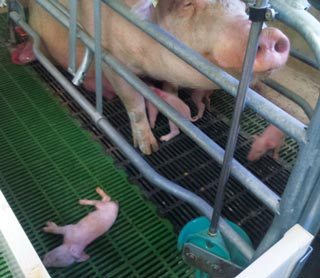
Good records of piglet mortality are fundamental to case studying. Detailed records describing casualties, type of piglets, when it happened and information about sows and farrowing progression (Table 5)10,22,23,47 are valuable to conducting a diagnosis and implementing strategies to mend it. Some of the most important points to consider in an investigation are:
Casualties can occur pre-farrowing, peri-farrowing and post-farrowing (Table 6)10 and may be differentiated. A good discrimination between the different types of dead piglets contributes to identifying cause of death.
Some problems – such as poor vigour, weakness, hypoxia, bleeding and infection – decrease the newborn’s chances of survival, but do not necessarily kill it. Real causes of death are, for example, hypothermia, hypoglycaemia, crushing, savaging umbilical bleeding out and septicaemia29. Some deaths are caused by multiple factors; for example, weak pigs have more chances of being crushed. On the other hand, stressed sows inhibit their milking conduct – so piglets get weak – and tend to crush piglets. Crushed piglets would look identical in these examples, but the picture of the whole litter and sow would be completely different. Piglet mortality records require proper data collection by trained staff, so the contribution of the different risk factors can be accurately evaluated. Further postmortem examinations and laboratory work can be extremely useful in the case of pathological signs – for example, scour or septicaemia.
A thorough study of risk factors is required so a practical approach to neonatal mortality reduction is achieved. Some breeding units have risk factors intrinsic to the system that can’t be amended. As long as neonatal mortality is a multifactorial problem, detection of secondary risk factors would offer options for introducing amendments. Also, the investigation should not focus only on dead piglets but also include sows, litter mates, environment, facilities, management protocols, staff and records.
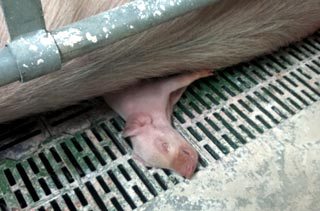
Good records and quality information from farrowing area staff allows identification of spatial and time patterns and answers questions such as what happened, when it happened and the source of the problem. Records of farrowing progress, cross-fostering and performances in previous cycles can help problems related to a sow or a group of sows be tracked down. Patterns can also be seen in the case of infectious disease affecting newborns; early detection increases treatment success and proper isolation hinders disease spread.
Good records describing when casualties occur are infrequent, but very valuable for monitoring variations and investigating problems. Literature reports 15% to 30% of pre-weaning mortality occurs in the first 24 hours after farrowing. The rate is around 20% on day two, 15% on the third and 10% on day four, so 70% of pre-weaning mortality usually occurs before day five3-6. Profile variations would help detection of emerging problems.
Variability in neonatal mortality among batches is normal; evident shifts are easy to detect, but insidious changes are frequently missed. Good records are very useful in detecting and resolving problems. Collection could be complicated and time-consuming in the first instance, but this reduces when it becomes routine.
Management protocols, hygiene, environmental conditions, gilts (and sow) health status, manpower dedication and technical staff training can always be improved. Neonatal (and pre-weaning) mortality have a great influence on the economic performance of a farm; working on reducing neonatal mortality could offer a good return of investment. Many cost-effective measures can be implemented. Pig producers should keep an inquisitive attitude when screening sub-optimal situations, setting little trials to improve management and reducing neonatal-mortality.